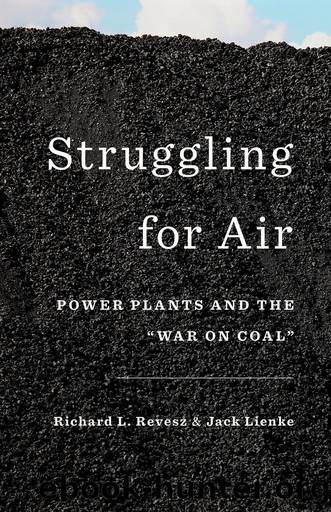Struggling for Air by Revesz Richard;Lienke Jack;

Author:Revesz, Richard;Lienke, Jack;
Language: eng
Format: epub
Publisher: Oxford University Press, Incorporated
Published: 2015-08-15T00:00:00+00:00
THE CARBON LOOPHOLE: A HISTORY
The basic mechanics of the greenhouse effect have been understood since 1859, when a British scientist named John Tyndall performed a series of experiments demonstrating the capacity of CO2 (then known as carbonic acid) and certain other gases to absorb heat.10 Just shy of forty years later, a pair of Swedish scientists, Arvid Högbom and Svante Arrhenius, became the first to speculate that emissions of CO2 caused by burning fossil fuels might strengthen this greenhouse effect (and thus increase global average temperatures) by increasing the concentration of CO2 in the atmosphere.11
But the technology necessary to test this theoryânamely, instruments capable of measuring the level of CO2 in the atmosphereâwouldnât arrive until the late 1950s. In 1958, an American chemist named Charles Keeling began to take continuous CO2 measurements from an observatory atop the Mauna Loa volcano in Hawaii.12 Plotted on a graph, these data points formed what would eventually be known as the âKeeling Curve,â an upwardly sloping line that has continued its climb for almost six decades nowârising from 315 parts per million in 1958 to just over 400 parts per million in 2014.13 (Meanwhile, the preindustrial concentration of CO2 is believed to have been about 275 parts per million.14)
By 1965, Keeling had accumulated enough data for President Lyndon Johnsonâs Science Advisory Committee to cite his findings in a report to the President as showing âclearly and conclusivelyâ that the carbon dioxide content of the atmosphere was rising.15 In the Committeeâs view, industrial society was conducting âa vast geophysical experimentâ with little understanding of the potential consequences:
Within a few generations, [humankind] is burning the fossil fuels that slowly accumulated in the earth over the past 500 million years. The CO2 produced by this combustion is being injected into the atmosphere; about half of it remains there.16
The Committee projected a 25 percent increase in CO2 levels by the year 2100 and advised that such an increase âmay be sufficient to produce measurable and perhaps marked changes in climate.â17 But in the absence of more sophisticated atmospheric modeling techniques, it was âimpossible to predict these effects quantitatively.â18
A year later, a report from the House of Representativesâ Subcommittee on Science, Research, and Development offered a similar assessment of the state of climate science: âThe net result is that we do know the carbon dioxide concentration has increased and is increasing. Once again, we do not know what this means or what to do about it if action is called for.â19 Presciently, the House report noted that if the harm of carbon dioxide emissions became clearer, the long-term desirability of coal as a fuel source would decrease:
The present investment in coal-fired electric generating plants, and the realistic cost differential between this and other energy sources, precludes any rapid demise of the coal industry. Further elucidation of the threat from carbon dioxide might alter this picture.20
But clarity on carbon was slow in coming.
Leon Billings, Senator Muskieâs longtime chief of staff, has written that he does ânot recall any talk about global warmingâ when the Clean Air Act was passed, in 1970.
Download
This site does not store any files on its server. We only index and link to content provided by other sites. Please contact the content providers to delete copyright contents if any and email us, we'll remove relevant links or contents immediately.
Second Nature (The Shape-Shifter Series #1) by Jae(1054)
Petroleum Contracts by Peter Roberts(868)
The Global Commons by Susan J. Buck(865)
Infrastructure by Frischmann Brett M(811)
The Monk by Matthew Lewis(791)
Japan Travel Guide: Things I Wish I Knew Before Going To Japan (2019 EDITION) by Fukuyama Ken & Fukuyama Yuki(777)
Ever After by William Wharton(746)
Before Earth Day by Karl Boyd Brooks(716)
Good for You, Great for Me by Lawrence Susskind(709)
War of the Whales by Joshua Horwitz(686)
Biting the Hands that Feed Us by Baylen J. Linnekin(679)
Respecting Animals by David S. Favre(655)
Animal Law in a Nutshell by Frasch Pamela & Hessler Katherine & Waisman Sonia(654)
Uncommon Ground by William Cronon(653)
Rangeland Systems by David D. Briske(643)
After Nature: A Politics for the Anthropocene by Jedediah Purdy(641)
The Ethics of Space Exploration by James S.J. Schwartz & Tony Milligan(633)
Fracking the Neighborhood by Jessica Smartt Gullion(608)
Down to the Wire: Confronting Climate Collapse by David W. Orr(601)
